Buying Diapers in Japan for Babies and Toddlers
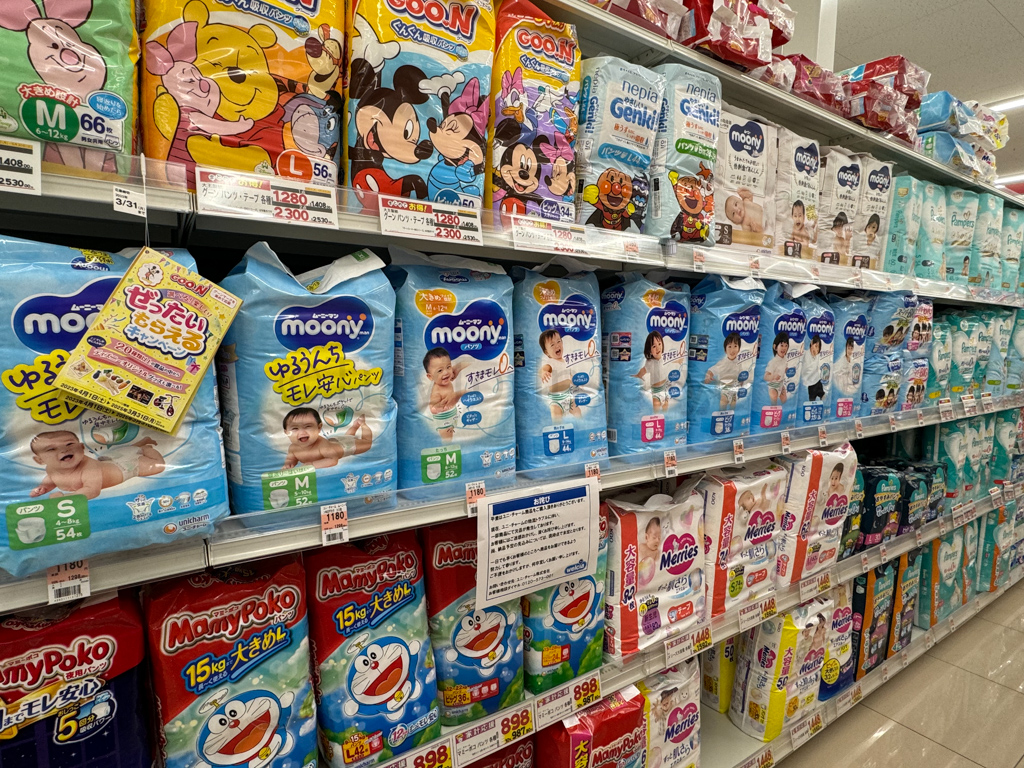
Last Updated on June 3, 2025 by Kay
This post may contain affiliate links, meaning I may earn a small commission on any purchases through those links at zero additional cost to you. Whatever I make goes to keeping this website running and I am forever grateful for the support. See my Privacy Policy for more information.
In Japan, diapers (おむつ, omutsu) are available at children’s stores like Akachan Honpo, Babies R Us, and Nishimatsuya, as well as large drugstores (e.g., Matsumoto Kiyoshi, Welcia) and supermarkets. Popular brands include Merries, Moony, Goo.N, Pampers, and MamyPoko. Diaper sizes are based on the baby’s weight, and options include tape-style and pull-up types.
In this article, I’ll share everything you need to know about diapers in Japan and give overviews of the types and brands for babies and toddlers, as well as sizes, so you know what to choose for your child. All of the information in this article is based on my experience living in Japan as a mother who has raised her child here since birth.
If you’re wondering about baby wipes, my favorite one is Merries.
For more information about baby wipes in Japan, in particular, looking for what’s flushable vs non-flushable, read this article.
Table of Contents
Where to Buy Diapers in Japan
Japan is a very convenient country, so unsurprisingly, it’s quite easy to find diapers here. You simply need to know where to look.
Most of these stores sell full packs, so you’ll unlikely to find anything travel-sized.
Tip: If you’re searching for diapers, look for a sign reading おむつ(オムツ) or ベビー用品, like the one below.
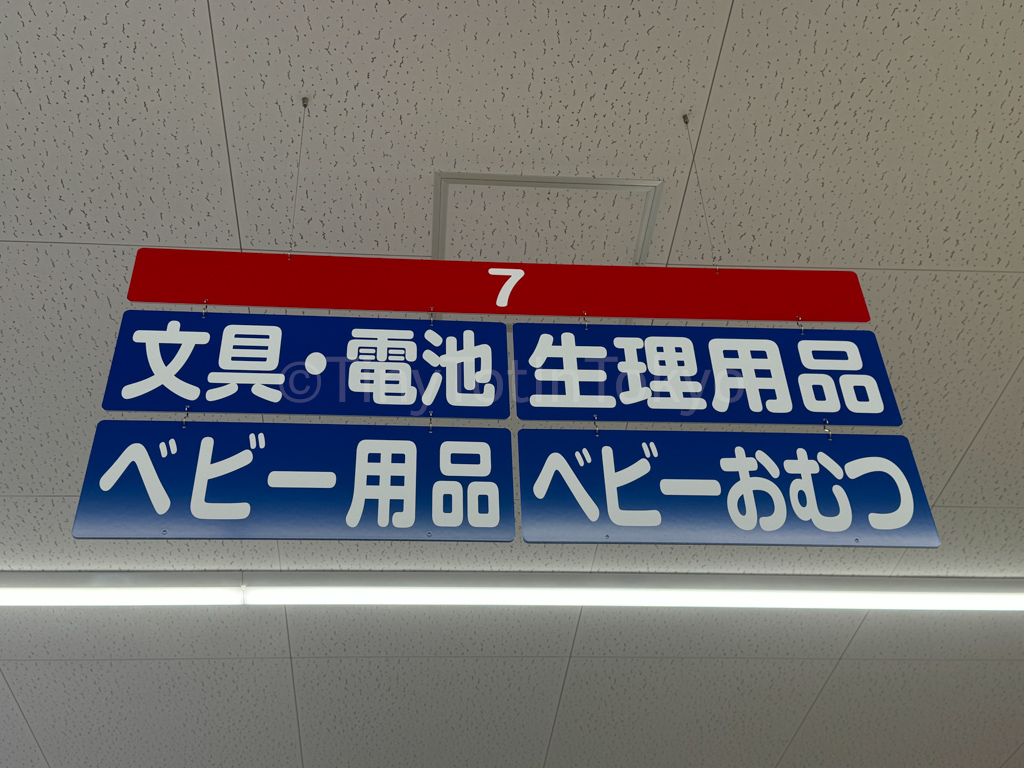
You can also ask a staff member, “Akachan no omutsu arimasuka?“. This means, “Do you have baby diapers?”.
Children’s Stores
These are the best places to get diapers for kids in Japan. In particular, Nishimatsuya, Babies R Us, and Akachan Honpo.
I’ve written an article about the different types of children’s stores in Japan and what you can find for your child, so I recommend giving it a read. These stores are amazing!
Drugstores
Large drugstores are likely to carry diapers for babies and toddlers. These are usually stand-alone stores, so don’t expect small drugstores, especially those in stations, to carry diapers.
The best drug stores where you’re most likely to find diapers are Cocokarafain (ココカラファイン), Matsu Kiyo (マツキヨ), and Welcia. You can also find diapers at Don Quijote.
Grocery Stores
Similar to drugstores, large grocery stores are more likely to sell diapers for babies and toddlers.
Convenience Stores
Sometimes you might be able to find diapers at convenience stores such as 7-Eleven and Family Mart. I wouldn’t spend much time looking for diapers here, though, because the selection is limited even if they do sell diapers.
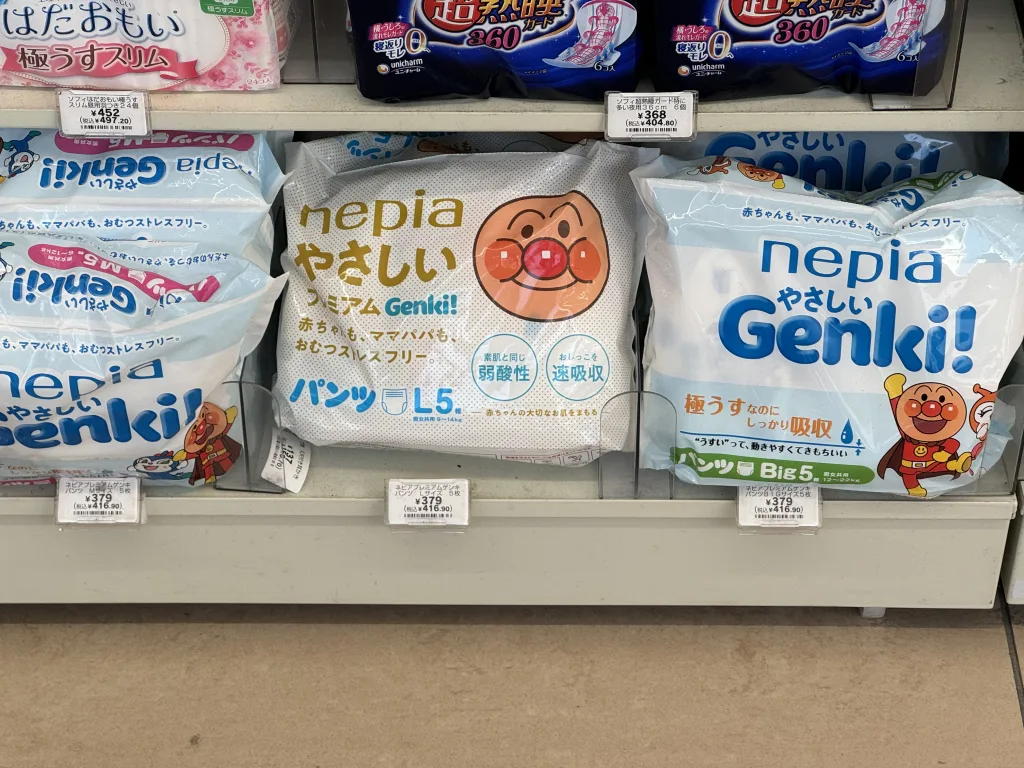
If you still need help finding diapers while you’re in Japan, ask your hotel or ryokan! They will be more than happy to help. You can even contact them in advance so they’ll be prepared.
Delivery Apps
If you don’t want to leave your house or hotel room, you can have groceries delivered to you via Uber Eats Japan or the delivery company Wolt, which is Doordash in Japan. My sister-in-law does this often, including to hotels, and finds it super convenient.
Here’s an example of how you can do this using the Wolt app.
Select “Pharmacies” or “Toys, Games, & Kids”.
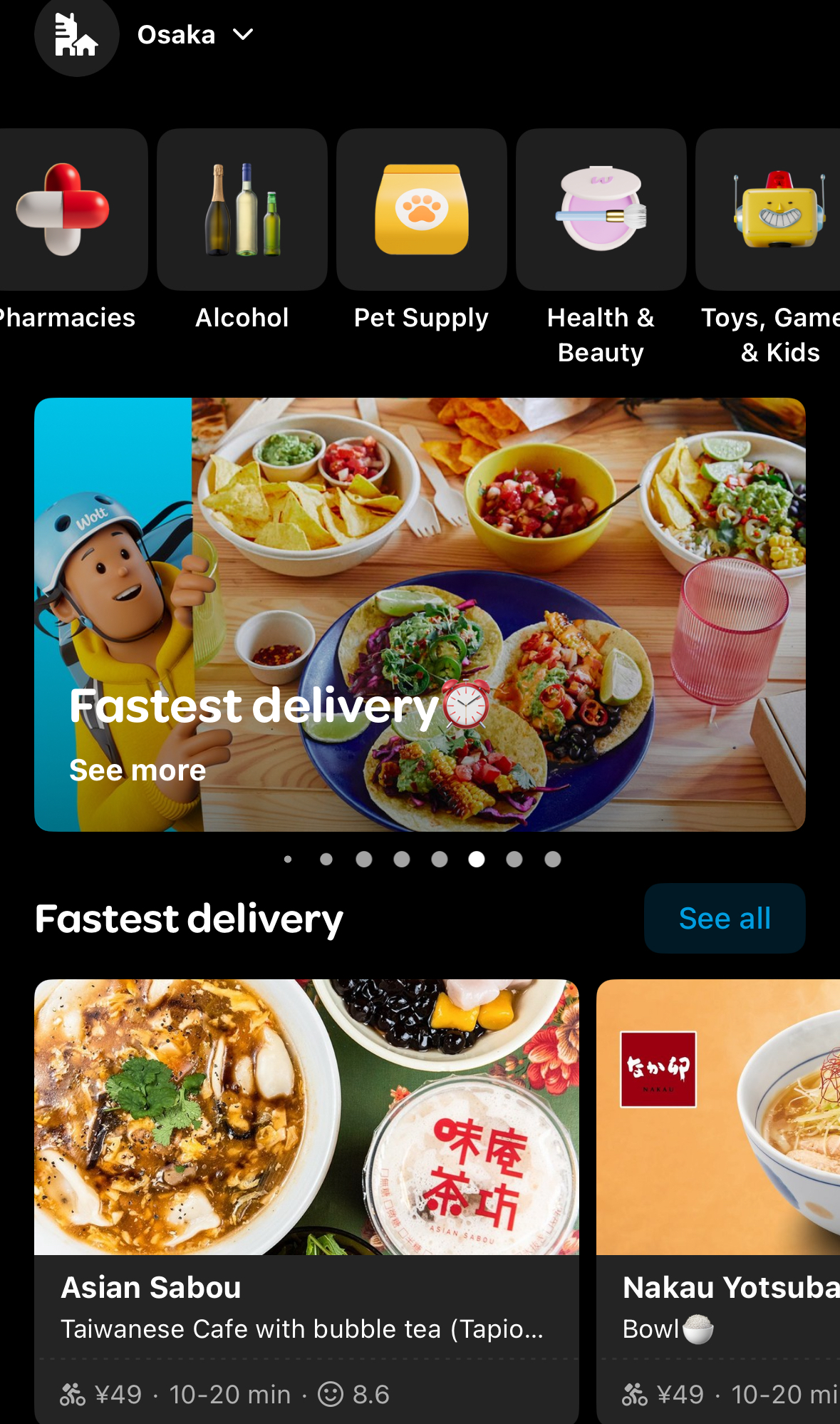
Select the store closest to you:

Select “baby maternity”:

Select the diapers you want. I’ll cover what you need to know about diapers in this article, so read further to learn more about which diapers would work best for your child.
Keep in mind that some pharmacies might not carry diapers, so you’ll need to keep looking until you find one. Of course, stores like Babies R Us (under the aforementioned “Toys, Games, & Kids” category) will carry diapers.

Tape Diapers vs Pull-Up Diapers
Like in most countries, there are two types of diapers in Japan — tape and pull-up (pants).
Tape-type (テープ)diapers have wings, tabs, or flaps (whatever you choose to call it!) that you attach onto the sides to secure the diaper on your baby. These are used for newborn babies up until around 10 months, or until the baby reaches a certain weight.
Read my article on tape-type diapers in Japan in detail, which includes hypoallergenic diapers.
Pull-up or pants-type (パンツ) diapers are similar to underpants and are for older babies and toddlers. The waist is stretchier than tape diapers, accommodating more active babies. In this article, I’ll be referring to these as “pull-up” diapers.
Read my in-depth article on pull-up diapers in Japan.
How to Read a Diaper Package in Japan
Diaper packages in Japan are very easy to understand.

You can also use Google Translate or Google Lens to look at everything on the package in detail if you like.
With pull-up diapers, the front of a diaper in Japan is labeled with the kanji 前 or hiragana まえ (mae), which means “front” while the back will have うちろ (ushiro), which means “back”, and a piece of blue-ended tape on it.
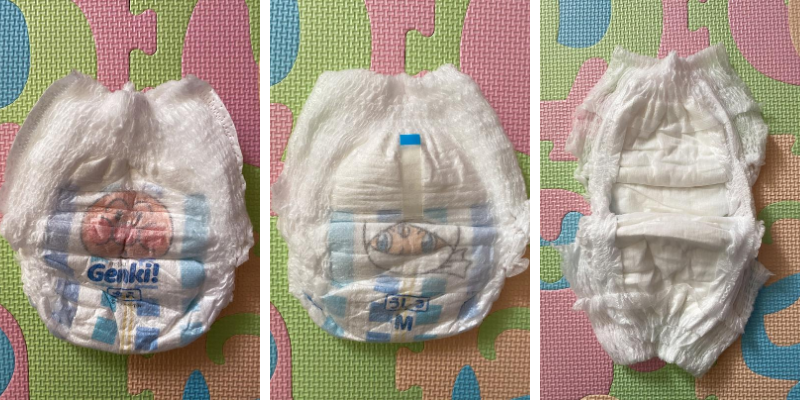
Diaper Size Chart in Japan
Here is a size chart for diapers in Japan:
| Size | Weight (kg) |
| 新生児 ・shinseiji (Newborn) | up to 5 |
| S | 4-9 |
| M | 6-12 |
| L | 9- 14 |
| ビッグ (BIG) | 12-22 |
| ビッグより大きい (XXL) | 13-28 |
The size is written on the bottom of the diaper package.
How to Throw Away Diapers in Japan
For tape-type diapers in Japan, roll up the diaper and then use the tape sides to close the diaper.
The video below shows how to put on a tape-type diaper as well as how to throw it away.
Pull-up diapers in Japan come with a piece of tape on the back. When disposing of a diaper, roll the diaper up, peel off the tape, and close the diaper using the tape.
If your child has solid poop, throw the poop from the diaper into the toilet. Do not throw away the diaper with the poop in it.
Unless there’s a bin specifically for diapers, place your diaper inside a small trash bag or a portable diaper trash bag before throwing it into a garbage bin.
Diaper Brands in Japan
There are several diaper brands in Japan, and deciding which one to buy might be overwhelming.
Pampers Hajimete no Hada e no Ichiban
The name Hajimete no Hada e no Ichiban translates to, “The best for (baby’s) new skin” and I found that this is very true!
Tape-type shown below.
And here is the pull-up (pants) type.
This was my diaper of choice when my daughter was a baby. It was soft, gentle on her skin, and didn’t leak. It also has the most elasticity out of all the tape-type diapers I tried in Japan, and was the longest from front to back.
According to Pampers, this additive-free diaper has a 3D mesh layer with 30 holes that absorb moisture and keep babies dry.
Notably, this diaper performed the best overall when I tested different tape-type diapers in Japan. The pull-up version came in third place.
This diaper was also voted as the best for newborns, as well as for older babies, and toddlers by parents in Japan.
Pampers Sarasara Care
This is a cheaper alternative to Pampers Hajimete no Hada e no Ichiban. And it seems to satisfy parents because it came in second place for the best newborn diapers, as voted by parents in Japan, as well as for older babies and toddlers.
Here is what the tape-type diaper package looks like.
And here is the pull-up type package.
These are lightweight and have good elasticity, but I felt that it wasn’t that great at absorbing liquid, despite that these diapers are supposed to last for 12 hours and are marketed as overnight diapers.
Merries
Made by the company Kao, Merries diapers are stretchy and more affordable than Pampers Hajimete no Hada diapers.
Pictured below is the tape type version.
And here is the pull-up type.
These diapers have thick padding, which I found too bulky when my daughter was a baby. However, I loved using the pull-up type diapers when my daughter was a toddler. It fit her just right, it felt soft, and it was amazing at absorbing liquid.
This diaper has also won awards from the Japan Mother’s Association and is a recipient of a Good Design Award in Japan. It came in third place for best newborn diaper and best diaper for babies and toddlers as voted by parents in Japan. This might be why it performed the best overall when I tested pull-up diapers in Japan.
These diapers also come in a First Premium version for babies and toddlers.
These claim to have “5-star softness” and are meant to be gentle while still preventing leaks from night until morning. The tape for these diapers has also won a Good Design Award.
moony (moonyman)
Made by unicharm, these diapers are additive-free and claim to prevent leaks, especially with the leg cuffs and back that both have a “loose stool stopper”. It is also supposed to be absorbent for 12 hours.
moony are the tape-type diapers while moonyman are the pull-up version.
Moonyman comes in various types according to your child’s needs such as regular (for all seasons):
Note that regular moonyman diapers are designed with gender in mind, so the blue packaging with 男の子 (otoko no ko) on it is for boys (like the one shown above) while the orange packaging with 女の子 (onna no ko) on it is for girls (as shown below).
Gender-neutral diapers have the kanji 男女 (boy and girl) on the package above the size.
These diapers also come in styles for babies who are rolling over, sitting, and/or crawling (寝返り〜はいはい):
As well as those who are standing and/or walking (たっち):
There’s also a type that’s meant to absorb sweat and good for summer (汗スッキリ):
And one for keeping bottoms warm in winter (冷えあんしん):
The organic version of these diapers is Moony Natural, which is made of organic cotton and plant-derived oils (rice, jojoba, and olive). According to Moony’s website, this diaper “has been certified by STANDARD 100 by OEKO‐TEX®, a textile product mark that indicates the highest safety level in the world”.
Genki!
Genki!, a diaper made by Nepia, are affordable diapers and perform quite well overall when it comes to feel and absorption. They have a triple ventilation technology that’s meant to help skin breathe and feel comfortable for babies and toddlers.
Here is what the tape-type diaper looks like.
And here’s the pull-up type.
I quite liked the pull-up version of these for my daughter and used it before switching to Merries.
Whito
This diaper brand, also by Nepia, is also quite soft and light, so it’s very portable. They come in both 3-hour and 12-hour types.
Below is tape-type for three hours.
And this is the pull-up type for 12 hours.
I didn’t like them, however, and found they performed very poorly. But at least these diapers are cute!
GOO.N
These are another affordable brand of diapers, which are made by elleair. It’s good for bigger babies and toddlers and apparently is good at absorbing odors.
Below is the tape type.
And this is the pull-up type.
I found that they were decent at absorbing liquid but I didn’t like the feel of these both dry and wet.
Sometimes you can find these diapers at DAISO.
They also have a version for sensitive skin, called GOO.N Plus.
Mamy Poko
These are probably the most affordable diapers in Japan. They only come in pull-up type, so they’re best for toddlers around 6 kg and up.
These are meant to last 12 hours thanks to their absorbent gel lining and has a stretchy waist to conform to different body types. However, I personally don’t like these diapers and found that they performed the worst in my diaper test.
Overnight Diapers in Japan
A few brands offer overnight diapers in Japan. Note that these only come in pull-up type.
Pampers Oyasumi (Good Night) Pants
These are affordable and I know many parents who are fans. One mom told me that these are the only ones that didn’t leak for her son.
Mamy Poko
These are the most affordable overnight diapers. I haven’t tried them, though.
Oyasumiman
These are the night version of moony diapers and were my go-to for my daughter. She never had a single leak in these and they fit her well.
Note that these are sold according to gender, the pink package is for girls and the blue is for boys.
GOO.N Night Junior
This is another one that I haven’t tried so I can’t personally comment on it. It seems like it’s for bigger kids, though, and can be used for kids that are up to 140 cm tall.
Swimming Diapers in Japan
If you want to take your child somewhere they can play in the water, you’ll want to get some swim diapers. Swim diapers are called 水遊び (mizu asobi) pants, mizu asobi meaning “playing in the water”, or スイミングパンツ (swimming pants).
These are easily found at the aforementioned children’s stores and larger drug stores in Japan.
moony Mizu Asobi Pants
This was my go-to for my daughter and I have no complaints! I mean, I couldn’t tell if she peed or if it leaked because the diaper was wet by the time she was done playing.
These are sold according to gender but it’s easy to tell since the boys’ package has a boy on it and a blue label, while the girls’ package has a girl on it and a pink label.
GOO.N Swimming Pants
These swim diapers are gender-neutral.
Wrap-up: Where to Buy Diapers for Babies and Toddlers in Japan
I hope this look at diapers for babies and toddlers in Japan has been helpful to you.
For other essential information on traveling with little ones in Japan, check out these articles:
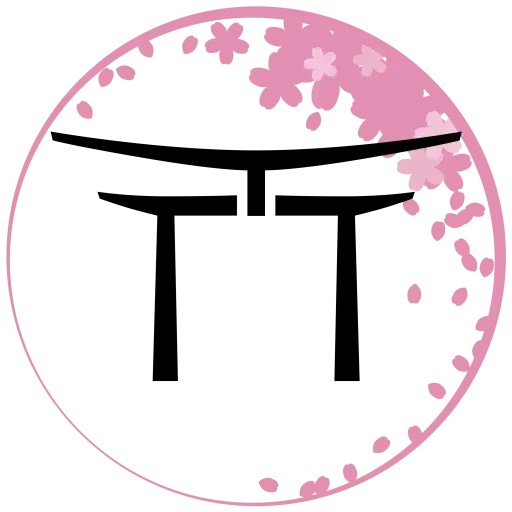
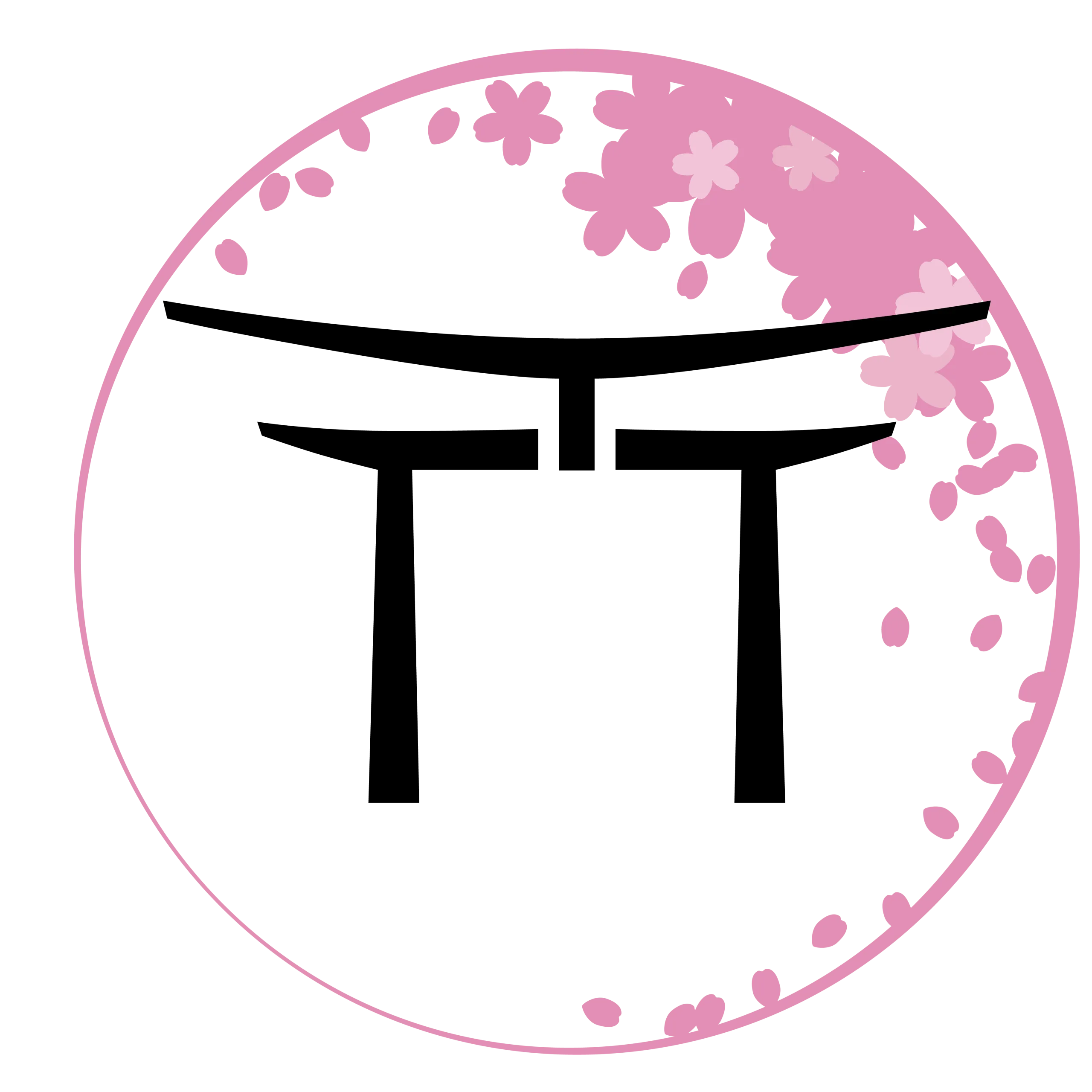

![パンパース 【テープ Sサイズ】 オムツ はじめての肌へのいちばん (4~8kg) 210枚(70枚×3パック) [ケース品] 【Amazon.co.jp限定】](https://m.media-amazon.com/images/I/41CS85l-iBL._SL500_.jpg)


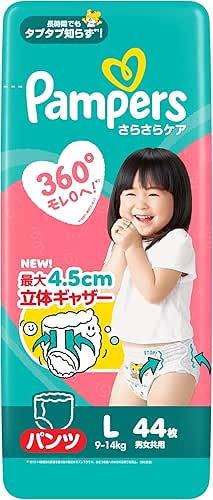
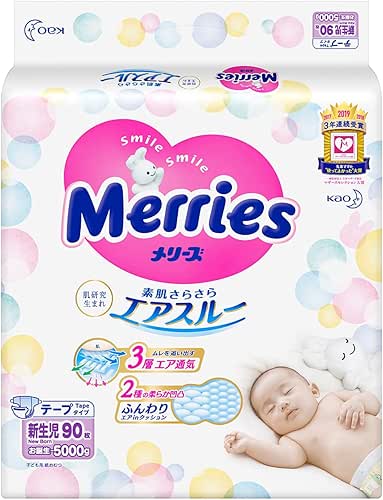

![【テープ Sサイズ】メリーズ ファーストプレミアム(4~8kg) 198枚(66枚×3パック) [ケース品] 2倍やわらかカシミヤタッチ 【Amazon.co.jp限定】](https://m.media-amazon.com/images/I/31QTyeJxEML._SL500_.jpg)

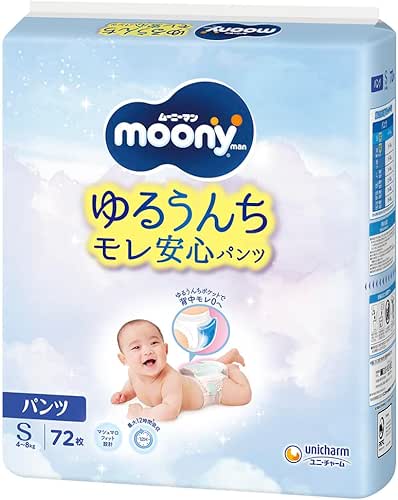


![【パンツ Mたっち】 ムーニーマン マシュマロ肌ごこち モレ安心 Mたっち おむつ (6~12kg)204枚(68枚×3) [ケース品] 【Amazon.co.jp限定】](https://m.media-amazon.com/images/I/71f-8OmWBCL._AC_SL500_QL70_ML2_.jpg)
![【パンツ Lサイズ】ムーニー 汗スッキリ 男女共用 オムツ(9~14kg)160枚(40枚×4) 〔2023年発売品〕[ケース品]](https://m.media-amazon.com/images/I/513kZLXcc9L._SL500_.jpg)






![【パンツ BIGサイズ】グーンプラス やわらかタッチ おむつ (12~22kg) 114枚(38枚×3) [ケース販売] 【Amazon.co.jp限定】 ≪ディズニーデザイン≫](https://m.media-amazon.com/images/I/51eDzlI01FL._SL500_.jpg)




![【夜用パッド BIGより大きいサイズ以上】グーン ナイトキッズ パッド (下着サイズ目安 90~140cm) 24枚 男女共用 [寝返りしてもズレにくい]](https://m.media-amazon.com/images/I/51YxwUnVARL._SL500_.jpg)

